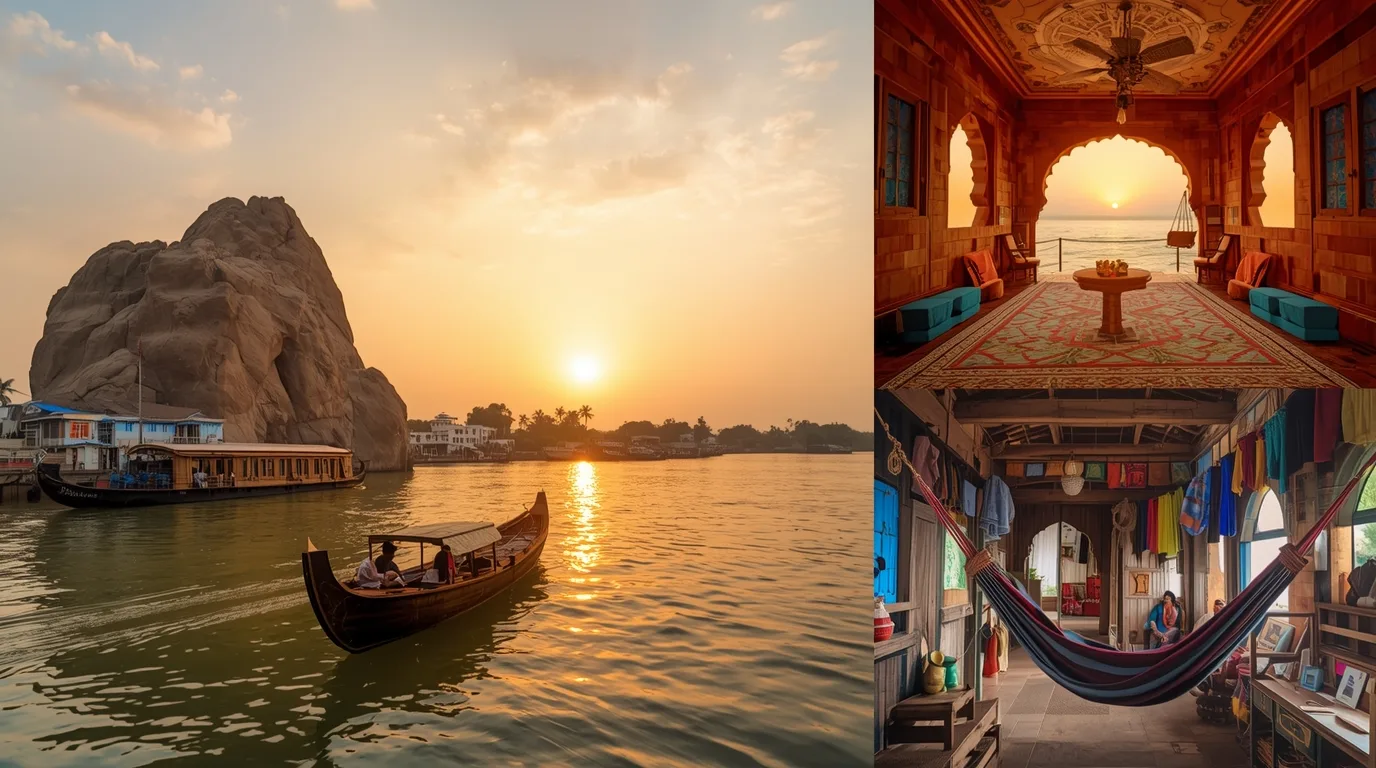Top Budget Travel Destinations in India to Explore in 2025 — Affordable Trips That Don’t Skimp on Experience
India is a huge country for tight budgets and big memories. In 2025, you can still explore dramatic ruins, misty hill stations, scenic beaches and soulful river towns without blowing your savings—if you pick the right places and plan smart. This guide lists the top budget travel destinations in India for 2025, explains why each place is wallet-friendly, the best months to go, and practical money-saving tips (cheap stays, transport hacks, low-cost activities).
You’ll find backpacker-friendly favourites—Hampi’s rockscape and affordable guesthouses, McLeod Ganj’s cheap Tibetan food and homestays, Rishikesh for river adventures and budget hostels, and Goa off-season for quiet beaches and low-cost stays. There are also quieter coastal gems like Gokarna, cultural hotspots such as Varanasi and Pushkar, and Kerala’s backwaters (Alleppey) where smart planning can turn a houseboat dream into a budget reality. Each destination entry includes concrete tips on where to save, what to splurge on, and how to experience the place like a local—without paying tourist premiums. Facts and seasonal notes are checked against travel sources and recent local guides so you can book with confidence. Pack light, travel slow, and enjoy rich experiences for less in 2025.
Introduction — why budget travel in India still wins (short)
Budget travel in India isn’t just about saving money—it's about stretching value. On a small daily budget you can eat like a local, sleep in friendly homestays, hire a bike for a day of exploration and still have money left for a couple of memorable splurges (a private boat ride, a guided trek, or a band-backed dinner). The destinations below were chosen because they offer high experience-per-rupee: scenic payoff, plenty of cheap accommodation, accessible transport, and memorable free or low-cost activities.
Top Budget Destinations (what makes each one special)
1. Hampi, Karnataka — ancient ruins and backpacker bliss
Why visit: Hampi’s surreal boulder-strewn landscape, ruined temples and sunset viewpoints feel otherworldly—and very friendly to shoestring budgets. Backpacker guesthouses and dorms cluster in Hospet and Hampi Bazaar, making it easy to meet fellow travellers and share rides.
Best time: October–February for cool mornings and clear skies. Avoid heavy monsoon months for safer bouldering and trekking.
Budget tips: Rent a bicycle or rented scooter for the day to explore ruins; buy entry tickets for the main complexes but wander freely in many areas; stay in guesthouses near the bazaar to save on food and transport.
What not to miss: Virupaksha Temple, Vittala Temple complex (stone chariot), sunset at Hemakuta Hill, and bouldering near the Tungabhadra river.
2. Varanasi, Uttar Pradesh — spiritual mornings on a coin-sized budget
Why visit: Varanasi is one of India’s oldest living cities; a sunrise boat ride on the Ganges and an evening aarti are two experiences that justify travel on any budget. Street food, cheap guesthouses near the ghats, and free cultural glimpses make Varanasi excellent value.
Best time: October–March for cool, pleasant weather—ideal for boat rides and long walks along the ghats.
Budget tips: Book shared boat rides or join early-morning group trips; eat at local eateries (kachaudi-chai breakfasts are cheap and delicious); choose basic guesthouses around Dasaswamedh or Godowlia for easy access to main ghats.
What not to miss: Sunrise boat ride, evening Ganga aarti, walk through the old city lanes and try local snacks.
3. Rishikesh, Uttarakhand — cheap adventure and yoga culture
Why visit: Rishikesh mixes backpacker hostels, budget yoga schools and low-cost adventure sports (white-water rafting in season). A number of budget hostels and riverside camps make extended stays inexpensive.
Best time: September–November and February–April for comfortable temperatures and good rafting conditions.
Budget tips: Choose dormitory beds near Laxman Jhula, book rafting with local operators in groups for discounts, and take free or donation-based yoga classes offered by several ashrams.
What not to miss: Ganga Aarti at Triveni Ghat, evening café culture in Tapovan, and a supervised rafting run on the Ganges.
4. McLeod Ganj / Dharamshala, Himachal Pradesh — Himalayan charm on a budget
Why visit: McLeod Ganj is affordable, culturally rich and welcoming to budget travellers. Cheap guesthouses, Tibetan bakeries and inexpensive guided treks (Triund) mean you can enjoy hill-country life without big spends.
Best time: March–June and September–November for trekking and clear views.
Budget tips: Sleep in family-run guesthouses, eat at local Tibetan cafés, and hike day-trips instead of paying for long guided treks. Triund is a popular low-cost overnight trek for first-time hikers.
What not to miss: Tsuglagkhang (Dalai Lama temple complex), Triund trek, Bhagsu Waterfall and the small Tibetan market.
5. Gokarna, Karnataka — beaches without the Goa price tag
Why visit: Gokarna is for travelers who want beach vibes with fewer crowds—and lower costs than peak-season Goa. Small beach huts, simple cafes and walking-access beaches like Kudle, Om and Paradise keep expenses down.
Best time: October–February for beach weather; monsoon months are greener and quieter (and cheaper) if you don’t mind the rain.
Budget tips: Stay in basic beach shacks or dorm-style cottages; cook your own food occasionally or eat at local shacks; explore beaches by foot to save on transport.
What not to miss: Sunrise on Kudle Beach, walking between beaches (Kudle → Om → Half Moon), and inexpensive yoga classes.
6. Goa (off-season), Goa — quiet beaches and low-cost stays (outside peak months)
Why visit: Goa isn’t always expensive—if you travel off-season (monsoon/shoulder months) you’ll find great deals on stays, fewer crowds and a lush green coastline. Off-season Goa is ideal for low-cost stays and a quieter vibe.
Best time for budget travel: June–September (monsoon/shoulder months) for deals; October–March for dry weather if you can pay peak prices.
Budget tips: Book last-minute guesthouses for big discounts during monsoon; choose South Goa beaches and homestays for better value than patrolled north Goa hotspots.
What not to miss: Quiet back-beach walks, local seafood shacks, and off-grid beaches near the Karnataka border.
7. Shillong & Cherrapunji (Meghalaya) — misty hills and waterfalls
Why visit: The Northeast offers dramatic monsoon-drenched scenery, living root bridges and waterfalls—often at lower daily costs compared with popular hill stations in the west. Shillong’s budget guesthouses and easy day trips to Cherrapunji or Mawlynnong make it a strong value pick.
Best time: October–May for clearer skies; monsoon months show the region at full, wild green but expect heavy rain.
Budget tips: Use shared taxis for day trips, stay in family-run guesthouses and eat local Khasi food to keep costs down.
What not to miss: Nohkalikai Falls, Mawlynnong village (Asia’s cleanest village), and Dawki river (boat rides).
8. Pondicherry / Auroville (Puducherry) — coastal calm and cheap hostels
Why visit: Pondicherry offers French-quartier charm and Auroville’s experimental community—both friendly to budget travellers through many inexpensive guesthouses and hostels. Beaches, cafés and day-bike rentals make it easy and cheap to explore.
Best time: October–March when the weather is pleasant.
Budget tips: Stay in Auroville hostels or cheap guesthouses; rent a bicycle or scooter for short trips; eat at local cafés and messes in the city.
What not to miss: Auroville sunrise, the Promenade in the French Quarter, and seafood from local shacks.
9. Alleppey (Alappuzha), Kerala — backwaters on a budget (plan smart)
Why visit: The Kerala backwaters are beautiful—and you can still experience them without splurging by choosing budget houseboats, day trips, or homestays that give local flavour. Compare prices and pick shared cruises or standard-class houseboats for affordability.
Best time: November–February for dry, pleasant weather.
Budget tips: Look for budget-class houseboats or shared cruise options; day trips and homestay experiences in villages alongside the canals are much cheaper than private luxury boats. Book in advance for peak season and compare local operators for the best deals.
What not to miss: A sunrise from the backwaters, village homestays, and local seafood.
10. Pushkar, Rajasthan — sacred, colourful and easy on the pocket
Why visit: Pushkar is famous for its peaceful lake, colourful ghats and, in November, the world-famous Camel Fair. Outside the fair, Pushkar remains a calm, affordable town with rooftop cafés and inexpensive guesthouses.
Best time: October–March for comfortable desert evenings; Camel Fair in November draws crowds (book early if you go then).
Budget tips: Stay in budget guesthouses near the lake, eat in tiny cafés or dal-chawal stalls, and use local buses or shared tuk-tuks for short hops.
What not to miss: Pushkar Lake, Brahma Temple, rooftop sunsets, and local bazaars.
Smart money-saving travel tactics for 2025
Travel off-peak & shoulder months. You’ll find cheaper rooms, quieter beaches and lower train/flight fares. Goa and many hill stations offer dramatic discounts in off-season.
Use hostels and family-run homestays. Dorm beds and small guesthouses cut lodging costs dramatically in most destinations (Pondicherry, Rishikesh, Hampi, McLeod Ganj).
Eat local, eat street. Meals from local cafés and dhabas are both tasty and cheap—this is where you’ll save most on food. (Rishikesh local thalis, Varanasi snacks, Pushkar rooftop cafés.)
Group the splurges. If a private houseboat or guided trek is a must, split the cost with other travellers. Shared tours and day trips cut per-head expenses.
Book trains and buses early. Indian Railways and state bus services often have early-bird availability and lower fares than last-minute travel. Use sleeper trains or Volvo buses for long overnight routes to save a night’s accommodation.
Safety and etiquette (short but important)
Check local weather and advisories before trekking or river activities—monsoon can affect accessibility in many places.
Respect local customs: temple dress codes, quiet hours in hill towns, and photography rules at religious sites.
Keep digital copies of ID and reservations; carry small cash for rural markets and shared taxis.
Conclusion — pick a place and go slow
Budget travel in India in 2025 rewards curiosity and patience. Choose a destination that matches your vibe—ruins and boulders in Hampi, spiritual mornings in Varanasi, beach relaxation in Gokarna or off-season Goa, or mountain air in McLeod Ganj—and plan a slow trip. Use local transport, sleep in guesthouses, share experiences and you’ll find that rich travel doesn’t require a rich budget. These ten destinations offer high-value experiences and friendly options for low-cost travellers—pack light, stay flexible, and enjoy the journey.












